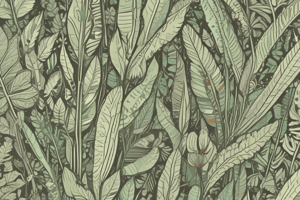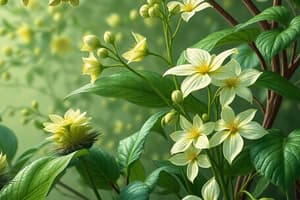Podcast
Questions and Answers
What is the goal of scientists trying to teach old crops new tricks?
What is the goal of scientists trying to teach old crops new tricks?
- To make crops more resistant to pests
- To make crops more tolerant to hot and dry conditions (correct)
- To make crops grow in different seasons
- To make crops grow faster
What is unique about orchids and agaves that allows them to thrive in hot and dry conditions?
What is unique about orchids and agaves that allows them to thrive in hot and dry conditions?
- They have adapted to hack photosynthesis (correct)
- They have thicker leaves to conserve water
- They have larger roots to absorb more water
- They have deeper roots to reach groundwater
What is the predicted effect of climate change on farmland?
What is the predicted effect of climate change on farmland?
- It will have no impact on farmland
- It will only affect certain regions
- It will make farmland less productive (correct)
- It will make farmland more productive
What is the target of scientists trying to improve crop yields?
What is the target of scientists trying to improve crop yields?
What is the dilemma that plants face in dry or hot environments?
What is the dilemma that plants face in dry or hot environments?
What is the predicted increase in crop yields if scientists are successful?
What is the predicted increase in crop yields if scientists are successful?
What is the main challenge that climate change poses to food production?
What is the main challenge that climate change poses to food production?
What is the projected population that the world will need to feed by the end of the century?
What is the projected population that the world will need to feed by the end of the century?
What is the risk of water loss in plants adapted to dry environments?
What is the risk of water loss in plants adapted to dry environments?
What is the main purpose of the 'light reactions' stage in photosynthesis?
What is the main purpose of the 'light reactions' stage in photosynthesis?
What is the name of the enzyme that grabs carbon dioxide in the 'dark reactions' stage?
What is the name of the enzyme that grabs carbon dioxide in the 'dark reactions' stage?
What is the term for plants that make a three-carbon molecule in one of the first steps of photosynthesis?
What is the term for plants that make a three-carbon molecule in one of the first steps of photosynthesis?
What happens when the pores in a leaf close to prevent water loss?
What happens when the pores in a leaf close to prevent water loss?
What is the percentage of plants that use the C3 photosynthesis pathway?
What is the percentage of plants that use the C3 photosynthesis pathway?
Why do plants in dry environments have fleshy leaves?
Why do plants in dry environments have fleshy leaves?
What is the result of rubisco's inability to function efficiently in hot temperatures?
What is the result of rubisco's inability to function efficiently in hot temperatures?
Study Notes
Scientists' Goal to Improve Crop Resilience
- Scientists are trying to engineer crops to thrive in harsher conditions, using secrets from plants like pineapples, orchids, and agaves that have adapted to hot and dry environments.
- The goal is to enable crops like rice and wheat to be grown in lands that are currently unsuitable for farming, potentially increasing crop yields by 50% or more.
Challenges of Climate Change
- Climate change is predicted to cause more droughts and reduce farmland productivity.
- The global population is expected to increase from 8 billion to 10 billion by the end of the century, making it essential to find solutions to mitigate climate change.
Photosynthesis and Its Limitations
- Photosynthesis is the process by which plants grow, using sunlight, water, and carbon dioxide to produce sugars and molecules.
- In dry or hot environments, plants face a dilemma: opening pores to let in carbon dioxide also leads to water loss.
- Traditional crop improvements have focused on traits like plant size, pest resistance, and growing season, but recent efforts have targeted photosynthesis.
Water-Saving Traits in Drought-Adapted Plants
- Plants adapted to dry environments, such as orchids, pineapple, agave, and sedum, have evolved water-saving traits, including fleshy leaves.
- These plants have also modified photosynthesis to minimize water loss.
Stages of Photosynthesis
- Photosynthesis occurs in two main stages: the "light reactions" and the "dark reactions".
- The "light reactions" capture photons from the sun to create energy-storing molecules, while the "dark reactions" use this energy to convert carbon dioxide into simple sugars.
C3 Plants and Their Limitations
- Most plants, including major food crops like rice, wheat, and soybeans, are C3 plants, which make a three-carbon molecule in the first step of photosynthesis.
- In these plants, both stages of photosynthesis occur simultaneously, making them vulnerable to water loss and reduced photosynthesis in hot and dry conditions.
Studying That Suits You
Use AI to generate personalized quizzes and flashcards to suit your learning preferences.
Description
Learn how plants adapted to dry environments have evolved to minimize water loss during photosynthesis. Discover the unique traits of plants like agave, orchids, and pineapple.




